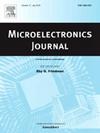A robust internal reference voltage generation circuit with self-adaptive calibration scheme for receiver in NV-DDR interface
IF 1.9
3区 工程技术
Q3 ENGINEERING, ELECTRICAL & ELECTRONIC
引用次数: 0
Abstract
This paper models and analyzes the impacts of impedance mismatch and synchronous switch noise (SSN) on data IO signals in NV-DDR interface. Based on the model, a robust internal reference voltage calibration scheme is proposed. This scheme utilizes a low-pass filter to extract the mid level of data eye diagram from the clock pattern data. According to the above level, a self-adaptive calibration loop based on successive approximation search (SAR) algorithm is adopted to quickly generate the internal reference voltage, thus ensuring the reliability of internal reference voltage. The proposed internal reference voltage generation circuit can reduce the interference of impedance mismatch and SSN, and adaptively generate the internal reference voltage in different interface modes. The test chip is fabricated in 180 nm CMOS process and the area occupies 0.0418 mm. The measurement results indicate that the internal reference voltage calibration error is within under diverse IO signals ranging from 800 MT/s to 2400 MT/s.
基于NV-DDR接口的接收机鲁棒内部基准电压产生电路及自适应校准方案
本文对NV-DDR接口中阻抗失配和同步开关噪声(SSN)对数据IO信号的影响进行了建模和分析。在此基础上,提出了一种鲁棒的内参考电压标定方案。该方案利用低通滤波器从时钟模式数据中提取数据眼图的中间层。根据上述水平,采用基于逐次逼近搜索(SAR)算法的自适应校准环路,快速生成内部参考电压,从而保证了内部参考电压的可靠性。所提出的内部参考电压产生电路可以减少阻抗失配和SSN的干扰,并在不同的接口模式下自适应产生内部参考电压。测试芯片采用180nm CMOS工艺制作,面积为0.0418 mm2。测量结果表明,在800 MT/s ~ 2400 MT/s的不同IO信号下,内部基准电压校准误差在0.5%⋅VccQ以内。
本文章由计算机程序翻译,如有差异,请以英文原文为准。
求助全文
约1分钟内获得全文
求助全文
来源期刊

Microelectronics Journal
工程技术-工程:电子与电气
CiteScore
4.00
自引率
27.30%
发文量
222
审稿时长
43 days
期刊介绍:
Published since 1969, the Microelectronics Journal is an international forum for the dissemination of research and applications of microelectronic systems, circuits, and emerging technologies. Papers published in the Microelectronics Journal have undergone peer review to ensure originality, relevance, and timeliness. The journal thus provides a worldwide, regular, and comprehensive update on microelectronic circuits and systems.
The Microelectronics Journal invites papers describing significant research and applications in all of the areas listed below. Comprehensive review/survey papers covering recent developments will also be considered. The Microelectronics Journal covers circuits and systems. This topic includes but is not limited to: Analog, digital, mixed, and RF circuits and related design methodologies; Logic, architectural, and system level synthesis; Testing, design for testability, built-in self-test; Area, power, and thermal analysis and design; Mixed-domain simulation and design; Embedded systems; Non-von Neumann computing and related technologies and circuits; Design and test of high complexity systems integration; SoC, NoC, SIP, and NIP design and test; 3-D integration design and analysis; Emerging device technologies and circuits, such as FinFETs, SETs, spintronics, SFQ, MTJ, etc.
Application aspects such as signal and image processing including circuits for cryptography, sensors, and actuators including sensor networks, reliability and quality issues, and economic models are also welcome.
 求助内容:
求助内容: 应助结果提醒方式:
应助结果提醒方式:


